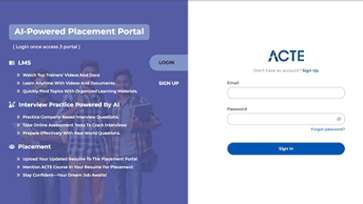LoadRunner is designed to assess the performance and scalability of applications under various conditions. LoadRunner allows testers to simulate real-world user behavior, generate heavy loads, and measure application response times and resource utilization. LoadRunner training is designed to equip individuals with the knowledge and skills required to effectively use LoadRunner for performance testing. The training typically covers various aspects of performance testing and LoadRunner's functionalities, preparing participants to conduct thorough performance tests on applications.
Additional Info
Future Prospects and Technologies of the Loadrunner
The future prospects of LoadRunner remain promising as the demand for robust and high-performing applications continues to grow. LoadRunner is expected to evolve and adapt to the changing landscape of software development and performance testing.
Continuous Integration and DevOps Integration: LoadRunner is likely to integrate more seamlessly with CI/CD pipelines and DevOps practices. Automation and continuous testing will become more critical to deliver high-quality applications quickly, and LoadRunner is expected to adapt to these evolving needs.
Cloud-Based Load Testing: With LoadRunner, customers will be able to conduct performance testing from different locations and scale up testing resources as necessary. LoadRunner is expected to keep adopting cloud-based solutions.
Support for Emerging Protocols and Technologies: As new technologies and protocols emerge, LoadRunner will likely extend its support to cover a broader range of applications, including those in emerging fields like IoT, blockchain, and edge computing.
AI and Machine Learning Integration: The incorporation of AI and machine learning into LoadRunner could revolutionize performance testing. These technologies could optimize test scenarios, analyze results more intelligently, and help identify performance issues with greater precision.
Real-Time Monitoring and Analytics: LoadRunner may evolve to provide more real-time monitoring and analytics capabilities, allowing testers to monitor applications under load and make data-driven decisions on the fly.
Shift-Left Performance Testing: The industry trend of "shift-left" testing, where performance testing is initiated earlier in the development process, is likely to continue. LoadRunner might adapt to support earlier and more frequent performance testing in agile and iterative development environments.
Cross-Platform and Cross-Browser Testing: Testing professionals will be able to evaluate the performance of applications on various hardware and browser combinations thanks to the potential expansion of LoadRunner's capabilities to include cross-platform and cross-browser testing.
The Importance of Loadrunner Training
- LoadRunner training holds immense importance as it empowers professionals with the necessary skills and knowledge to conduct effective performance testing.
- LoadRunner is a powerful tool with a wide range of functionalities, and training ensures that individuals can make the most of its capabilities.
- LoadRunner Course is essential for professionals and organizations alike. It enables individuals to conduct accurate performance testing, optimize application performance, and advance their careers.
- Understanding LoadRunner's features, such as Vuser scripting, load distribution, and result analysis, enables testers and performance engineers to simulate real-world scenarios accurately.
- Through LoadRunner Course, professionals learn how to conduct precise performance tests, which are essential for identifying potential bottlenecks and issues in applications. This knowledge is invaluable in optimizing application performance and ensuring that applications can handle the expected user load without any performance degradation.
- For individuals, LoadRunner training opens up exciting career opportunities in the performance testing and quality assurance domains. As the demand for performance testing expertise grows, professionals with LoadRunner skills become highly sought after in the job market.
- One of the significant benefits of LoadRunner Course is the ability to reduce testing time and costs. Efficient testing practices, learned through training, enable testers to identify performance issues early in the development process.
Loadrunner Training's Advantages for Companies and Developers
LoadRunner training offers significant advantages for companies and developers, contributing to the overall success of software development and performance testing processes. Here are the benefits for both:
Advantages for Companies:
High-Quality Applications: LoadRunner training ensures that companies can conduct thorough performance testing, identifying and addressing performance issues early in the development cycle. This leads to the delivery of high-quality applications that perform well under various user loads.
Optimized Performance: Well-trained LoadRunner professionals can optimize application performance, making sure that the application can handle expected user traffic without experiencing performance degradation. As a result, there is an improved user experience and greater user satisfaction.
Cost-Effectiveness: Efficient performance testing through LoadRunner training helps companies identify and rectify performance bottlenecks during the testing phase, saving costs associated with post-production fixes.
Enhanced Reliability: LoadRunner training enhances the reliability and stability of applications by simulating real-world usage scenarios and ensuring that applications can handle the expected load.
Competitive Advantage: Companies that invest in LoadRunner training for their teams gain a competitive advantage by delivering high-performance applications that outperform their competitors.
Advantages for Developers:
Specialized Skills: LoadRunner training equips developers with specialized skills in performance testing, making them valuable assets to the organization.
Career Growth: Developers with LoadRunner expertise have enhanced career opportunities in performance engineering and quality assurance roles.
Improved Collaboration: LoadRunner training fosters collaboration between developers and testers, creating a more integrated and efficient development process.
Real-World Application Testing: Through LoadRunner training, developers gain experience in testing real-world application scenarios, leading to a deeper understanding of application behavior under different loads.
Confident Code Optimization: LoadRunner training enables developers to analyze application performance metrics and optimize their code for better performance and scalability.
The Objectives for Enrolling in the Loadrunner Program
- Enrolling in the LoadRunner program comes with specific objectives that participants aim to achieve. These objectives drive individuals to gain the necessary skills and knowledge to become proficient in performance testing using LoadRunner.
- The primary objective is to become proficient in performance testing concepts, methodologies, and best practices. Participants aim to understand the significance of performance testing in delivering high-quality applications and ensuring a seamless user experience.
- Enrollees seek to acquire the skills to identify performance bottlenecks and issues in applications under different load conditions. By learning LoadRunner's functionalities, they can pinpoint performance weaknesses and devise solutions to optimize application performance.
- Participants aspire to contribute positively to their organizations' software quality by conducting comprehensive performance tests using LoadRunner. They aim to ensure that applications meet performance requirements and deliver a superior user experience.
- The program's objectives include providing hands-on experience with LoadRunner through practical exercises and real-world projects. Participants aim to apply their knowledge to simulate real-life testing scenarios and enhance their problem-solving abilities.
- The LoadRunner program often aligns with career advancement goals. Participants aim to enhance their employability and open doors to opportunities in performance testing, quality assurance, and performance engineering roles.
Tools utilized for Loadrunner
LoadRunner utilizes several components and tools to perform comprehensive performance testing. These tools work together to simulate user behavior, analyze application performance, and identify performance bottlenecks. The main tools utilized for LoadRunner are:
Virtual User Generator (VuGen): VuGen is used to create Vuser scripts that emulate user actions on the application being tested. It records user interactions and allows script customization for various protocols and technologies.
LoadRunner Controller: The Controller manages the entire performance testing process. It sets up test scenarios, defines the number of virtual users, distributes the load across multiple load generators, and monitors the test execution.
Load Generators: Load generators are machines responsible for generating a large number of virtual users to simulate the desired user load on the application. These machines run the Vuser scripts created in VuGen.
LoadRunner Analysis: After performance tests are executed, LoadRunner Analysis is used to interpret and analyze the test results. It provides in-depth performance metrics, graphs, and reports to identify performance bottlenecks and assess application performance.
Web Tours Sample Application: LoadRunner includes a sample web application called "Web Tours" that can be used for practice and testing during training or learning.
JMeter: Apache JMeter
is a popular open-source load testing tool for evaluating the performance of online applications. It may be used for functional testing, load testing, and stress testing and supports a number of methods.
Gatling: Gatling is a free and open-source load testing software designed for ease of use and scalability. It is particularly well-suited for testing web applications and supports the HTTP and WebSocket protocols.
BlazeMeter: Users may build, carry out, and analyse performance tests using the cloud-based BlazeMeter platform from different parts of the world. It provides integrations with well-liked CI/CD systems and supports many protocols.
Neoload: A commercial load testing tool called Neoload offers a full range of functionality for testing online and mobile apps, APIs, and other network protocols.
WebLOAD: The load testing tool called WebLOAD is renowned for being simple and user-friendly. For load testing websites, mobile applications, and APIs, it supports a number of protocols.































